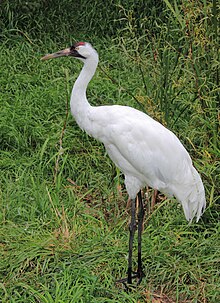The muskeg of the taiga in Wood Buffalo National Park, Alberta, Canada, and the surrounding area was the last remnant of the former nesting habitat of the Whooping Crane Summer Range. However, with the recent Whooping Crane Eastern Partnership Reintroduction Project, whooping cranes nested naturally for the first time in 100 years in the Necedah National Wildlife Refuge in Central Wisconsin, USA.
The whooping crane was declared endangered in 1967. Attempts have been made to establish other breeding populations in captivity. The whooping crane is endangered mainly as a result of habitat loss, although whoopers are also still illegally shot despite this being subject to substantial financial penalties and possible prison time.
At one time, the range for these birds extended throughout midwestern North America. In 1941, the wild population consisted of 21 birds. Conservation efforts have led to a population increase; as of April 2007 there were about 340 whooping cranes living in the wild, and another 145 living in captivity. The whooping crane is still one of the rarest birds in North America. The United States Fish and Wildlife Service confirmed that 266 whooping cranes made the migration to Aransas National Wildlife Refuge in 2007. In Wood Buffalo National Park, the Canadian Wildlife Service counted 73 mating pairs in 2007. They produced 80 chicks, of which 40 survived to the fall migration, and 39 completed the migration to Aransas National Wildlife Refuge.
The whooping crane was declared endangered in 1967. Attempts have been made to establish other breeding populations in captivity. The whooping crane is endangered mainly as a result of habitat loss, although whoopers are also still illegally shot despite this being subject to substantial financial penalties and possible prison time.
At one time, the range for these birds extended throughout midwestern North America. In 1941, the wild population consisted of 21 birds. Conservation efforts have led to a population increase; as of April 2007 there were about 340 whooping cranes living in the wild, and another 145 living in captivity. The whooping crane is still one of the rarest birds in North America. The United States Fish and Wildlife Service confirmed that 266 whooping cranes made the migration to Aransas National Wildlife Refuge in 2007. In Wood Buffalo National Park, the Canadian Wildlife Service counted 73 mating pairs in 2007. They produced 80 chicks, of which 40 survived to the fall migration, and 39 completed the migration to Aransas National Wildlife Refuge.
| Whooping Crane | |
|---|---|
 | |
| Conservation status | |


No comments:
Post a Comment